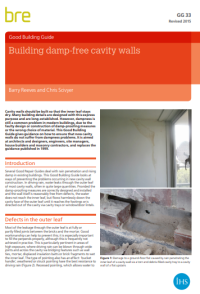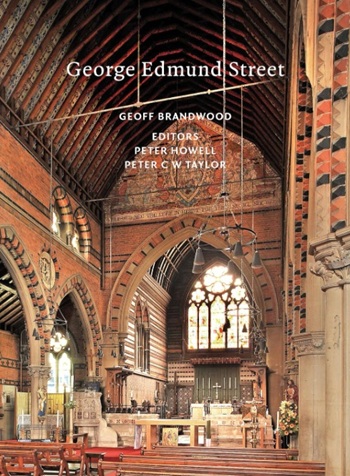Building damp-free cavity walls
BRE (Building Research Establishment) is an independent, research-based consultancy, testing and training organisation, operating in the built environment and associated industries.
Building damp-free cavity walls (GG 33 revised) was written by Barry Reeves and Chris Scivyer and published by BRE on 18 March 2015.
In driving rain, water leaks through the outer leaf of most cavity walls, often in quite large quantities. Provided the damp-proofing measures are correctly designed and installed and the wall itself is reasonably free from defects, this water does not reach the inner leaf, but flows harmlessly down the cavity face of the outer leaf until it reaches the footings or is directed out of the cavity via cavity trays or window/door lintels.
However, even though many cavity wall details are long-established and designed with the express purpose that the inner leaf stays dry, dampness is still a common problem. This is generally due to faulty design or construction of damp-proofing measures or the wrong choice of materials.
This 6-page Good Building Guide replaces guidance published in 1999, and offers advice about how to ensure new cavity walls do not suffer from damp. It is intended for architects and other designers, engineers, site managers, house builders and masonry contractors.
Its contents are:
- Introduction.
- Defects in the outer leaf.
- Problems caused by wall ties.
- Defects linked to cavity insulation.
- Where damp-proof courses and cavity trays are needed.
- Installing damp-proof courses.
- Installing cavity trays.
- Weepholes.
- Conclusion.
- References.
- Further reading.
[edit] Find out more.
[edit] Related articles on Designing Buildings Wiki
- BRE articles on Designing Buildings Wiki.
- BRE Buzz articles on Designing Buildings Wiki.
- BRE Buzz.
- BREEAM.
- Building Research Establishment.
- Cavity tray.
- Cavity wall.
- Damp in buildings.
- Damp proof membrane.
- Damp proofing.
- Damp-proof course.
- Dew point.
- Diagnosing the causes of dampness (GR 5 revised).
- Penetrating damp.
- Understanding dampness.
- Wall ties.
- Weep hole.
Featured articles and news
Delivering for tenants; National Retrofit Hub
New report offers recommendations to strengthen energy efficiency standards to protect private renters.
Government consultations for the summer of 2025
A year of Labour, past and present consultations on the environment, the built environment, training and tax.
CMA competitiveness probe of major housing developers
100 million affordable housing contributions committed with further consultation published.
Homes England supports Greencore Homes
42 new build affordable sustainable homes in Oxfordshire.
Zero carbon social housing: unlocking brownfield potential
Seven ZEDpod strategies for brownfield housing success.
CIOB report; a blueprint for SDGs and the built environment
Pairing the Sustainable Development Goals with projects.
Types, tests, standards and fires relating to external cladding
Brief descriptions with an extensive list of fires for review.
Latest Build UK Building Safety Regime explainer published
Key elements in one short, now updated document.
UKGBC launch the UK Climate Resilience Roadmap
First guidance of its kind on direct climate impacts for the built environment and how it can adapt.
CLC Health, Safety and Wellbeing Strategy 2025
Launched by the Minister for Industry to look at fatalities on site, improving mental health and other issues.
One of the most impressive Victorian architects. Book review.
Common Assessment Standard now with building safety
New CAS update now includes mandatory building safety questions.
RTPI leader to become new CIOB Chief Executive Officer
Dr Victoria Hills MRTPI, FICE to take over after Caroline Gumble’s departure.
Social and affordable housing, a long term plan for delivery
The “Delivering a Decade of Renewal for Social and Affordable Housing” strategy sets out future path.
A change to adoptive architecture
Effects of global weather warming on architectural detailing, material choice and human interaction.
The proposed publicly owned and backed subsidiary of Homes England, to facilitate new homes.
How big is the problem and what can we do to mitigate the effects?
Overheating guidance and tools for building designers
A number of cool guides to help with the heat.
The UK's Modern Industrial Strategy: A 10 year plan
Previous consultation criticism, current key elements and general support with some persisting reservations.
Building Safety Regulator reforms
New roles, new staff and a new fast track service pave the way for a single construction regulator.




























Comments
Building damp-free cavity walls involves proper design, construction, and maintenance to prevent the accumulation of moisture within the cavity space. Cavity walls are constructed with an outer and inner leaf separated by a gap known as the cavity. Here are some essential steps to ensure damp-free cavity walls:
1. Proper Design:
Ensure that the cavity wall system is correctly designed to include adequate ventilation and drainage measures. A well-designed cavity will allow water to drain away from the wall effectively.
2. Quality Materials:
Use high-quality materials for the cavity wall construction. This includes appropriate bricks or masonry for the outer and inner leaves, along with durable cavity wall ties and insulation.
3. Cavity Wall Insulation:
Proper insulation helps regulate the internal temperature of the building and prevents condensation. Use suitable insulation materials, and ensure they are correctly installed without gaps or voids.
4. Damp-Proof Course (DPC):
Install a damp-proof course between the inner and outer leaves of the wall. The DPC acts as a barrier to prevent moisture from rising from the ground and entering the building.
5. Cavity Wall Ventilation:
Incorporate ventilation openings at the top and bottom of the cavity to allow air circulation and moisture escape. This helps to maintain dry conditions within the cavity.
6. Cavity Wall Weep Holes:
Weep holes are small openings at the bottom of the cavity wall that allow any water that enters the cavity to drain out. These weep holes should be kept free from obstructions.
7. Cavity Wall Flashings:
Use appropriate flashings, such as lead or plastic, around openings like windows and doors to prevent water from entering the cavity.
8. Regular Inspection and Maintenance:
Periodically inspect the cavity walls for any signs of damage, cracks, or issues that may lead to water penetration. Address any problems promptly to maintain a damp-free cavity.
9. External Landscaping:
Ensure that the ground level surrounding the building slopes away from the walls. This helps to divert rainwater and prevents it from collecting around the base of the building.
10. Address Water Leakage:
If you notice any water leakage or dampness within the cavity wall, investigate the source of the problem and rectify it immediately. This may involve repairing or replacing damaged flashings, weep holes, or pointing.
By following these guidelines and using best practices in cavity wall construction, you can significantly reduce the risk of dampness and ensure the longevity and integrity of the building's structure. It's essential to work with experienced architects, builders, and construction professionals to ensure that all the necessary measures are taken to create damp-free cavity walls.